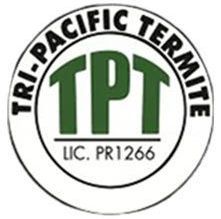FAQs
Tri-Pacific Termite
Have a question about termites? We have the answer. Check out these FAQs and give us a call today for more information!
What does a plumbing leak specifically have to do with termites?
Plumbing leaks create high moisture conditions in wood, which are ideal environments for termites and other wood-destroying organisms. These moist areas are prone to costly fungus damage. Our trained inspectors can detect leaks early, potentially saving you significant repair expenses. Regular inspections of these areas are crucial for preventing termite infestations and associated damage.Are there any other wood-destroying organisms I need to worry about?
While termites are the primary concern, other wood-destroying organisms can cause significant damage. Powder-post beetles are second to termites in destructiveness and can inflict extensive harm before detection. Carpenter ants and carpenter bees are also threats. All these organisms thrive in high-moisture conditions, often caused by plumbing issues or damaged seals. Early detection and moisture control are essential in preventing infestations and fungal growth.If you have never seen termite swarms in your home, could you still have termites?
Termites can indeed be present even if you haven't observed swarms. These insects operate primarily within wood or underground, making them difficult to detect. Swarming events are brief, typically lasting under an hour, and occur infrequently. It's possible to miss these short-lived swarms or for a colony to not swarm at all. Regular professional inspections are crucial for early detection of termite activity.Why do you need to test the shower and check the toilet seal?
Inspecting showers and toilet seals is crucial as these areas are prone to leaks, which create moisture-rich environments attractive to wood-destroying organisms. Our inspectors examine these spots to ensure they're watertight, preventing conditions that encourage infestations. It's important to note that if shower door removal is necessary for repairs, state law may require replacement with safety glass, potentially incurring additional costs.What are the difference between Section 1 and Section 2 findings?
Section 1 findings refer to visible, active evidence of infestation by termites, carpenter ants, wood-boring beetles, or fungal infections. Section 2 findings indicate conditions that could lead to future infestations or infections, such as excessive moisture or earth-to-wood contact. During property transactions, lenders typically require Section 1 issues to be addressed before sale completion.Is termite inspection important?
Termite inspections are critical for property protection. Every area of your property, especially wood and soil contact points, requires thorough examination. Our skilled inspectors can identify subtle signs of termite activity that untrained eyes might miss. For property sellers, early inspections can reveal necessary repairs and provide cost estimates for termite clearance. Tri-Pacific Termite Co. offers a 10% discount for pre-escrow inspections, making it a cost-effective preventive measure.

Share On: